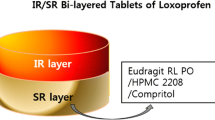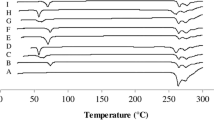Abstract
Several matrix tablet formulations (hydrophilic-based, wax-based, and three-layer tablets) were designed for controlling the release of the highly water soluble drug, venlafaxine hydrochloride (VenHCl) for once-daily administration. The three-layer tablets consist of non-swellable, compritol-based middle layers containing the drug to which hydrophilic top and bottom barrier layers were applied. A 23 full-factorial design was employed for optimization and to explore the effect of different variables on the release rate of the drug from the three-layer tablets. The optimized levels of each independent variable were based on the criterion of desirability. The calculated values of f 1 and f 2 were 4.131 and 79.356, respectively; indicating that the release profile of the optimized PEO layered tablet formulation is comparable to that of the target release model. The pharmacokinetic parameters of VenHCl from the optimized three-layer tablet was compared to the marketed extended release capsule as a reference in healthy human subjects using a randomized crossover design. In this study, the 90% confidence interval for AUC0–24 and AUC0−∞ are within (0.8–1.25), which satisfied the bioequivalence criteria. It could be concluded that a promising once-daily extended-release three-layer tablet of the highly water soluble drug, VenHCl, was successfully designed.









Similar content being viewed by others
REFERENCES
de Oliveira RA, Cunha GM, Borges KD, de Bruin GS, dos Santos-Filho EA, Viana GS, et al. The effect of venlafaxine on behaviour, body weight and striatal monoamine levels on sleep-deprived female rats. Pharmacol Biochem Behav. 2004;79:499–506.
Gohel MC, Soni CD, Nagori SA, Sarvaiya KG. Modulation of venlafaxine hydrochloride release from press coated tablet. Indian J Pharm Sci. 2008;70:292–7.
Gohel MC, Bariya SH. Fabrication of triple-layer matrix tablets of venlafaxine hydrochloride using xanthan gum. AAPS PharmSciTech. 2009;10:624–30.
Makhija SN, Vavia PR. Once daily sustained release tablets of venlafaxine, a novel antidepressant. Eur J Pharm Biopharm. 2002;54:9–15.
Abdul S, Poddar SS. A flexible technology for modified release of drugs: multi layered tablets. J Control Release. 2004;97:393–405.
Chidambaram N, Porter W, Flood K, Qiu Y. Formulation and characterization of new layered diffusional matrices for zero-order sustained release. J Control Release. 1998;52:149–58.
Efentakis M, Peponaki C. Formulation study and evaluation of matrix and three-layer tablet sustained drug delivery systems based on Carbopols with isosorbite mononitrate. AAPS PharmSciTech. 2008;9:917–23.
Conte A, Maggi L, Colombo P, la Manna A. Multi-layered hydrophilic matrices as constant release devices (GeomatrixTM Systems). J Control Release. 1993;26:39–47.
The United States Pharmacopeia 30/The National Formulary 25. Rockville: USP Convention; 2006.
Wagner JG. Interpretation of percent dissolved-time plots derived from in vitro testing of conventional tablets and capsules. J Pharm Sci. 1969;58:1253–7.
Higuchi T. Rate of release of medicaments from ointment bases containing drugs in suspension. J Pharm Sci. 1961;50:874–5.
Higuchi T. Mechanism of sustained-action medication. Theoretical analysis of rate of release of solid drugs dispersed in solid matrices. J Pharm Sci. 1963;52:1145–9.
Korsemeyer RW, Gurnya R, Doelkera E, Buria P, Peppas NA. Mechanisms of solute release from porous hydrophilic polymers. Int J Pharm. 1983;15:25–35.
Peppas NA. Analysis of Fickian and non-Fickian drug release from polymers. Pharm Acta Helv. 1985;60:110–1.
Sinha Roy D, Rohera BD. Comparative evaluation of rate of hydration and matrix erosion of HEC and HPC and study of drug release from their matrices. Eur J Pharm Sci. 2002;16:193–9.
Mandrioli R, Mercolini L, Cesta R, Fanali S, Amore M, Raggi MA. Analysis of the second generation antidepressant venlafaxine and its main active metabolite O-desmethylvenlafaxine in human plasma by HPLC with spectrofluorimetric detection. J Chromatogr B Analyt Technol Biomed Life Sci. 2007;856:88–94.
Mahaguna V, Talbert RL, Peters JI, Adams S, Reynolds TD, Lam FY, et al. Influence of hydroxypropylmethylcellulose polymer on in vitro and in vivo performance of controlled release tablets containing alprazolam. Eur J Pharm Biopharm. 2003;56:461–8.
Bernardi LS, Oliveira PR, Murakami FS, Silva MAS, Borgmann SHM, Cardoso SG. Characterization of venlafaxine hydrochloride and compatibility studies with pharmaceutical excipients. J Therm Anal Cal. 2009;97:729–33.
Phaechamud T. Variables influencing drug release from layered matrix system comprising hydroxypropylmethylcellulose. AAPS PharmSciTech. 2008;9:668–74.
Li FQ, Hu JH, Deng JX, Su H, Xu S, Liu JY. In vitro controlled release of sodium ferulate from Compritol 888 ATO-based matrix tablets. Int J Pharm. 2006;324:152–7.
Liu J, Zhang F, McGinity JW. Properties of lipophilic matrix tablets containing phenylpropanolamine hydrochloride prepared by hot-melt extrusion. Eur J Pharm Biopharm. 2001;52:181–90.
Qiu Y, Chidambaram N, Flood K. Design and evaluation of layered diffusional matrices for zero-order sustained-release. J Control Release. 1998;51:123–30.
Singh J, Philip AK, Pathak K. Optimization studies on design and evaluation of orodispersible pediatric formulation of indomethacin. AAPS PharmSciTech. 2008;9:60–6.
Rekhi GS, Nellore RV, Hussain AS, Tillman LG, Malinowski HJ, Augsburger LL. Identification of critical formulation and processing variables for metoprolol tartrate extended-release (ER) matrix tablets. J Control Release. 1999;59:327–42.
Solanki AB, Parikh JR, Parikh RH. Formulation and optimization of piroxicam proniosomes by 3-factor, 3-level Box-Behnken design. AAPS PharmSciTech. 2007;8:E86.
Velasco MV, Ford JL, Rowe P, Rajabi-Siahboomi AR. Influence of drug:hydroxypropylmethylcellulose ratio, drug and polymer particle size and compression force on the release of diclofenac sodium from HPMC tablets. J Control Release. 1999;57:75–85.
FDA Center for Drug Evaluation and Research. Guidance for industry: dissolution testing of immediate release solid oral dosage form. Rockville: FDA; 1997.
Author information
Authors and Affiliations
Corresponding author
Rights and permissions
About this article
Cite this article
Aboelwafa, A.A., Basalious, E.B. Optimization and In vivo Pharmacokinetic Study of a Novel Controlled Release Venlafaxine Hydrochloride Three-Layer Tablet. AAPS PharmSciTech 11, 1026–1037 (2010). https://doi.org/10.1208/s12249-010-9467-z
Received:
Accepted:
Published:
Issue Date:
DOI: https://doi.org/10.1208/s12249-010-9467-z




